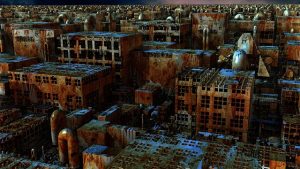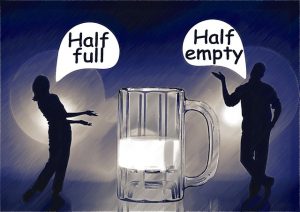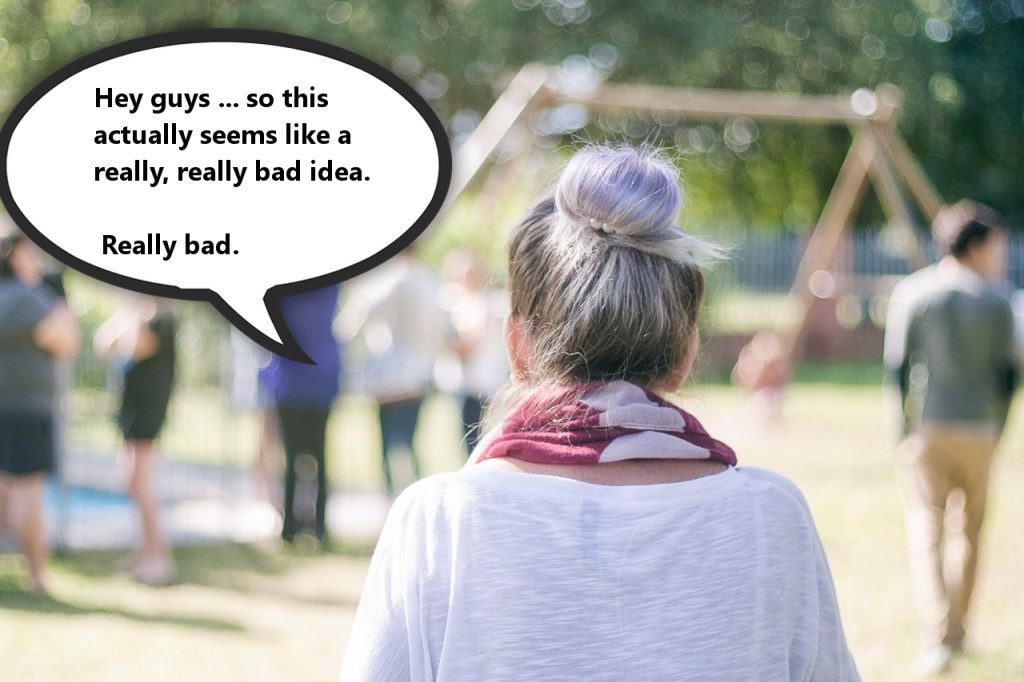If you’ve watched the movies Divergent, The Hunger Games, or Maze Runner and thought, “Whoa, these are amazingly original stories! Why hasn’t someone thought of this before?” you might be surprised to learn that this type of story is nothing new.
Stories with dystopian themes have been around for a long time.
What you probably won’t be surprised to learn is that analyzing and writing about dystopian literature has been around for about as long as the literature itself.
And if you’re reading this post, I wouldn’t be surprised to learn that you’re planning to write about dystopian literature—specifically dystopian short stories.
So if you’re in need of a little help choosing stories and narrowing your focus, here are four popular dystopian short stories to compare and contrast.
A Little About the Dystopian World
Dystopia is pretty much the opposite of utopia.
While a utopian world means people live in peace and harmony with all the joy they could hope for, a dystopian world means that people live in a world that’s full of fear, oppression, and control.
Sure, upon first glance, a dystopian world looks awesome. After all, someone (like the government or a corporation) has made a world that seems to be everything its citizens could ask for. But in reality, people dream of (and often fight for) a better existence.
This general premise of dystopian society holds true in just about all dystopian literature.
A Brief Reminder About Compare and Contrast Essays
On the surface, compare and contrast essays seem super-easy because all you need to do is pick things and start writing about how they’re the same and how they’re different, right?
Not quite. While you do need to establish points to both compare and contrast, your paper needs to have a focus.
Here’s what I mean.
If you’re writing a compare and contrast essay about two restaurants, you can’t just start comparing the atmosphere, the food, the prices, the staff, and the location. Without focus, you’re just writing a list of random points about the restaurant.
To create a well-written essay, establish a focus. Choose three or four key points that you can connect to the focus of your paper.
For instance, if you’re comparing restaurants, your paper might examine food, atmosphere, and prices. You’d base your comparisons on something like whether the restaurant is kid-friendly or whether it would make a great place for a first date.
Need more tips on writing a compare and contrast essay? Read these posts:
- Compare and Contrast Essay Tips From a Kibin Editor
- This Compare and Contrast Essay Outline Will Help You Beat Writer’s Block
- 2 Compare and Contrast Essays Examples Worth Emulating
Now that you have some background info about dystopian literature and compare and contrast essays, let’s move on to comparing four dystopian short stories.
How to Compare and Contrast 4 Popular Dystopian Short Stories
Remember when I said that dystopian literature had been around a long time?
As evidence, we’re going to work with four short stories that have been around for quite awhile—one of them was written more than a century ago.
(It seems that people have always been afraid of having corrupt governments, losing their freedoms, and/or destroying the planet.)
While there are certainly plenty of dystopian short stories and dystopian novels to choose from, this post will focus on the following four dystopian short stories:
- The Machine Stops by E.M. Forster (originally published in 1909): Though this short story is sometimes considered a novella due to its slightly longer length, it can still be classified as a short story. Forster seems to predict the internet in this story and focuses on the technology-dependent lives of people who live underground after radiation makes the Earth’s surface uninhabitable.
- The Lottery by Shirley Jackson (originally published in 1948): When you think of the lottery today, you assume you’re the lucky winner of millions of dollars. That’s not the case in Shirley Jackson’s version. People gather in the town square each summer to draw a villager’s name. The winner, however, is never happy to win this lottery.
- Harrison Bergeron by Kurt Vonnegut (originally published in 1961): In this story, Vonnegut satirizes society’s tendency to want to make everyone equal and illustrates the negative effects of technology.
- The Ones Who Walk Away from Omelas by Ursula Le Guin (originally published in 1973): Like “The Lottery,” this story begins on a summer day during a festival. Everyone in the town seems to live an idyllic life, but there’s a dark undertone. Many live in guilt as they know that their happiness comes at a price.
Of course, there are just about as many ways to compare and contrast dystopian short stories as there are stories, but we’re going to focus on the following points of comparison:
Fair warning: The comparisons below contain spoiler alerts. If you want to experience the full effect of these stories, go read them before you read the rest of this post. I’ll wait.
Comparing and contrasting theme
Dependence on technology
Both “The Machine Stops” and “Harrison Bergeron” rely heavily on technology and the dangers of technology. All the characters in “The Machine Stops” live a secluded life, totally dependent on technology and “The Machine” for their existence.
Though the characters in “Harrison Bergeron” aren’t dependent on technology to live, they have technology forced upon them. They’re required to wear various handicaps to create equality.
“Harrison Bergeron” illustrates the power technology (in this case television) can have over people as they sit and mindlessly watch. “The Machine Stops” illustrates a similarly passive society that mindlessly watches lectures on video screens.
One of the key differences in the use of technology in the two stories is the type of existence created by the technology.
“The Machine Stops” uses technology to isolate people, forcing them to live alone underground with no human contact. “Harrison Bergeron” uses technology in an attempt to create harmony among people by making them all equal and thus better able to coexist.
Happiness at a price
In both “The Lottery” and “The Ones Who Walk Away from Omelas,” one person is sacrificed for the good of the whole.
One person’s name is drawn in “The Lottery” and is stoned to death to ensure a bountiful harvest.
One child is selected to be locked away and suffer alone in “The Ones Who Walk Away from Omelas” in order for the rest of the town to live in happiness.
Dangers of blindly following tradition
Both “The Lottery” and “The Ones Who Walk Away from Omelas” sacrifice a community member for the happiness of others. No real reason is given for the origin of these rituals. The community simply follows the procedures because that’s the way it’s always been done.
They blindly follow because that’s what they’re supposed to do. Few stop to consider whether these rituals should be continued and/or how they might save the lives of those being sacrificed.
How these themes are relevant today
Dystopian literature is known for warning readers about the dangers of what could happen if society continues on its current path.
Both “The Machine Stops” and “Harrison Bergeron” illustrate the dangers of over-dependence on technology, technology addiction, and how technology can negatively impact society.
It’s not too difficult to look at both of these stories and see how addiction to smartphones and isolation due to technology relate to today’s world.
Dystopian literature also warns readers of the dangers of blindly following. In all four of these short stories, people’s lives are negatively affected (or ended) because people simply followed along and refused to stand up for their beliefs.
People today continue to stand up for injustices in society. Two current examples include the Me Too movement and the Black Lives Matter movement.
Check out this example essay to read one writer’s comparison of the themes in “Harrison Bergeron” to today’s society.
Comparing and contrasting narration
Third-person objective point of view
“The Machine Stops,” “Harrison Bergeron,” and “The Lottery” all use third-person objective point of view. This essentially means that a narrator (who is not a character in the story) actually tells the story but remains objective while doing so.
In each of these stories, the action unfolds, and readers get to see inside the minds of characters as they act and react to situations. This style of narration lets readers get into the minds of characters without the outside influence of a narrator’s own point of view.
Third-person objective (and occasionally first-person) point of view
“The Ones Who Walk Away from Omelas” uses third-person objective point of view as well. The narrator presents only a limited amount of information to readers and remains mainly objective throughout.
However, “The Ones Who Walk Away from Omelas” also uses first-person narration at times. The narrator speaks in first person to directly address the readers and allow them to relate more closely with the characters.
How different points of view affect the story and its readers
As you compare and contrast narration, you might also want to consider why the author chose a specific type of narration. Consider how the story might change if presented from another point of view.
Take, for example, “Harrison Bergeron.” The story is told objectively by a third-person narrator. Readers see a little bit of every character and learn about characters’ lives through dialogue and description.
How would the story be different if told from Harrison’s point of view? The story would certainly show more of his thoughts as he planned his actions and tried to rebel against the system. Through his point of view, readers would learn of the evils of government control.
If, on the other hand, the story was told from the point of view of a government official, readers might learn of the necessity of handicaps and the need to create equality.
You might also consider how “The Lottery” would change if, for example, a first-person narrator opened the story with a commentary about the evils of the tradition of stoning a villager.
This condemnation of the lottery would, of course, insert a value judgment on the tradition and would completely take away the suspense created in the story. Readers would immediately know the gruesome details of the lottery ritual. (Talk about a spoiler alert!)
All of those who actually walk away in “The Ones Who Walk Away from Omelas” can be considered rebels. Why? Because they don’t agree with sacrificing a child for the happiness of others.
The key difference here is that some so-called rebels simply walk away. It’s sort of an “out of sight, out of mind” philosophy. They don’t agree with what’s being done, but they don’t do anything to stop it, either.
“The Ones Who Walk Away from Omelas” also includes a fair number of those who disagree with sacrificing a child yet continue to live in the community and do nothing to stop it. They believe it is necessary to maintain their society and their own happiness.
To get another perspective on the characters and their decisions to stay or walk away from Omelas, read this example essay.
The importance of both types of characters
Dystopian literature relies on those who accept and those who rebel to illustrate the following:
- The current state of the society and what it has become.
- The dreams of those who believe there can be a better world.
Again, because dystopian literature often serves as a warning to current society, it’s easy to apply these types of characters to today’s society.
For instance, many people are fine with discrimination and choose to do nothing. But there are plenty of other people who choose to fight and change the current culture.
Need a Few More Ideas?
There are times (and this may be one of them) that you read something and think, “Eh, none of these ideas really work for me. I wish I knew of other points to compare and contrast.” If that’s what you’re thinking, then you’re in luck.
If you want to consider other literary terms to use as the basis of your compare and contrast paper (or another type of literary analysis paper), take a look at these posts:
- 15 Literary Terms You Need to Know to Write Better Essays
- Writing About Literature: 9 Things You Need to Know
If you want an in-depth discussion of select literary terms, these posts have you covered:
- How to Analyze Imagery in Literature the Smart Way
- How to Identify and Write About Literary Symbols With Confidence
Looking for an additional refresher about analyzing a short story? Read How to Write a Short Story Analysis the Smart Way.
Finally, if the apocalypse hasn’t forced you underground or rendered all essays obsolete, why not have a Kibin editor help you refine your writing and offer some expert advice?






